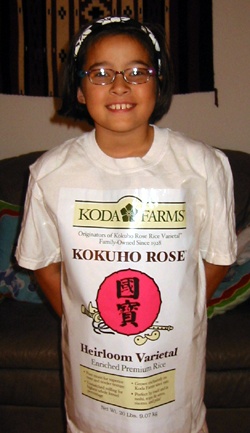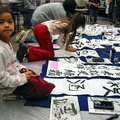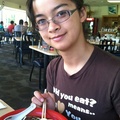The doorbell rings. The dog barks. I turn on the porch light, open the front door, and…
No one is there. Then I look down. A package!
Ooh, I was not expecting any more Christmas presents. I bend down to pick it up, and I hear the unmistakable sound of …
Rice.
A box of rice. A very big box of rice. Who would ship me a very big box of rice?
I stagger into the house, the sound of trickling and flowing rice filling my ears, and I put the very big box down on the kitchen table. I look at the label to see who in the world would FedEx me a very big box of rice and smile when I read, “Koda Farms.
I open the box and inside is a 20-pound bag of Koda Farms rice, the heirloom variety, and a little package of new heirloom organic brown rice, too. My knees go weak. You cannot buy regular Koda Farms rice in Michigan (only sweet rice and mochiko).
Koda Farms is California’s oldest family-owned and operated rice farm and mill, established in 1928 by Keisaburo Koda. I met the beautiful Robin Koda once years ago at TK Farm’s mochitsuki, where friends and family were pounding rice to make mochi in preparation for the new year.
Until I received this infusion of my favorite rice, I simply did not have the heart to write about Japanese New Year or Oshogatsu. I discretely tried to get myself invited to the Aramakis’ here in town, but they are going to the Shimouras’. All I could think was how much I missed making the rounds with my parents to all their Japanese American friends’ homes to visit and to eat our way into the new year.
First stop: TK Farms, home of the wonderfully warm Kubota clan, which has practically adopted my mother. I barely walk in the door when Mrs. Kubota sets a new place at the table and serves a bowl of warm ozoni soup—full of kamaboko, naruto, konbu, tofu, and most important, mochi. She explains that you must eat mochi first thing on New Year’s Day to ensure good luck and long life through the new year.
Once you have eaten your ozoni soup and are now protected for the year, then you can settle down to the rest of the osechi ryori (New Year’s food) set out in beautiful lacquered three-tiered juubako bento boxes—sushi, sashimi, kuromame, kazunoko, gobo, konbu, and a steady stream of shrimp and vegetable tempura straight out of the oil.
At the Ling-Nakanos’, the Chinese extended family also adds fried rice, pot stickers, Chinese chicken salad and glazed pecans to the mix.
One year, my father visited three homes in one day and ate so much that he thought he was having a heart attack. By the time the paramedics arrived, he was starting to feel better. Diagnosis: Too much wasabi. “Next time,” they suggested, “When you’re full, stop eating.”
Easier said than done when you have a lot of family friends, because Oshogatsu is not really about the food. For me, it is about visiting your family’s friends and your friends’ families, hosting graciously, always another place at the table. I am so touched by this 20-pound bag of rice FedEx’d to my door by the daughter of a friend of a family whose daughter is friends with my mother. It seems crazy by “American standards” that we would be friends. Yet here, so far from home, I bask in the expansive reach of my family and their friends.
* This article was originally written on November 17, 2011 and published at annarbor.com.
© 2011 Frances Kai-Hwa Wang





